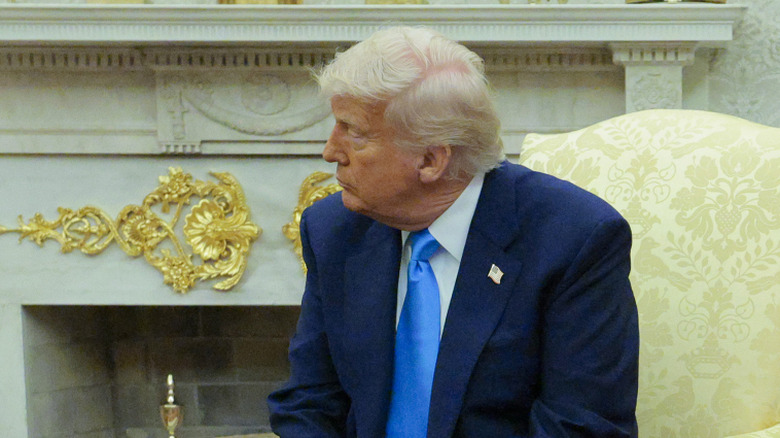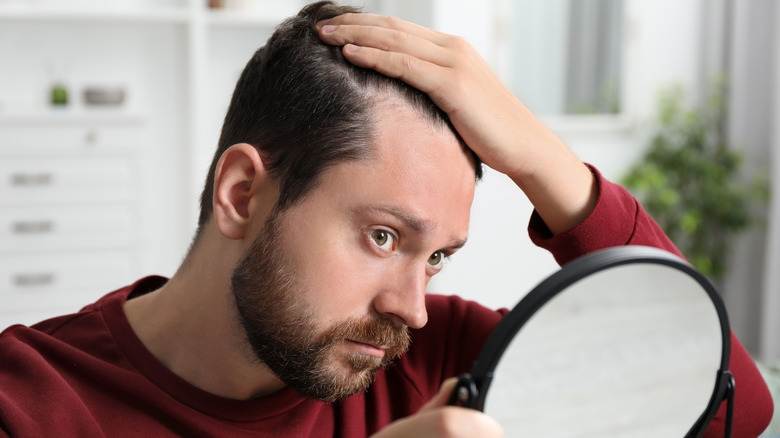Could Trump's Regular Bleach Jobs Be Contributing To Hair Loss? Here's What We Know
Like many people, President Donald Trump has gone through some noticeable hair changes over the years. Although the length of his hair has stayed pretty consistent since the '80s, the color has definitely shifted. Back then, his hair was mostly light brown or dark blond, but he started going for lighter tones while hosting "The Apprentice." During his first term as president, he was noticeably more blond. When he surrendered to law enforcement officials in Georgia, he listed his hair color as "blond or strawberry" (per Associated Press).
You may not have spotted this in his past health reports, but his 2018 exam listed Propecia as one of his medications (via Time). Propecia is used to treat male pattern baldness. His 2020 health records showed he was taking 1 milligram of finasteride, the generic form of Propecia. However, neither drug appeared in his 2025 report.
In May 2025, people noticed a bald spot on the top of Trump's head during a meeting with South African President Cyril Ramaphosa (per The Independent). While two-thirds of men deal with male pattern baldness, it's worth noting that harsh hair dyes can also lead to thinning or hair loss.
Trump's bleach jobs might make hair loss more noticeable
If you're someone who hits the salon every few weeks for a color refresh, you probably know how dye can mess with your hair. Both salon and at-home box dyes are packed with chemicals that can weaken your strands, making them more prone to breakage. That means more hair showing up in your brush or clogging your shower drain. Whether you're going lighter or darker, you might notice more shedding.
But that doesn't necessarily mean your hair won't grow back. Hair dye doesn't penetrate down to the follicle, so the hair underneath can still grow. In the case of male pattern baldness (aka androgenic alopecia), it's a different story. The hair follicles shrink over time, which makes each strand thinner. Eventually, the hair stops growing altogether.
(Read about top debunked myths concerning hair loss.)
According to Hims, hair dye doesn't cause male pattern baldness, but it can make it more noticeable by increasing hair breakage. Frequent dye jobs can make things worse, especially ones involving bleach or permanent color. Trump is also 79, and as people age, it's normal to lose more hair and experience slower hair growth. Strands also get finer with age, which can add to the overall look of thinning.
How men can reduce hair loss
If you're starting to notice a receding hairline, minoxidil is one of the most common over-the-counter treatments for hair loss. According to the American Academy of Dermatology Association, clinical trials show that minoxidil can not only slow hair loss but also help stimulate new growth. You can still color your hair while using it — just make sure not to apply minoxidil right before or after your coloring session. To keep seeing results, you'll need to use it consistently.
Although Trump no longer uses finasteride, this oral medication has been shown to slow hair loss in many men. Unlike minoxidil, finasteride is less likely to regrow hair but can help you hang onto what you've got. It works best if you start taking it before significant hair loss begins. That said, finasteride does come with potential side effects like reduced sex drive, erectile dysfunction, or depression. If you stop taking finasteride, hair loss usually picks up again. Other options include hair transplants or platelet-rich plasma (PRP) injections, both of which can help treat thinning hair or balding areas.


